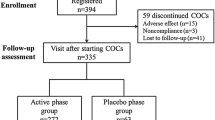Abstract
Abstract
Women with a previous history of thromboembolic disease have often been denied oral emergency contraception because of a theoretical concern about increasing their risk of thrombosis.
Methods
Eleven healthy volunteers with regular periods were recruited to the study. A thrombophilia screen was done at the first visit and they each had four measurements of Factor VII and antithrombin III taken at mid-cycle for two cycles. In the third cycle, emergency contraception was given mid-cycle and blood samples were taken 1, 3 and 7 days later. A further four samples were taken during the following cycle and, where the cycle had been significantly foreshortened due to the emergency contraception, a fifth cycle was monitored. The treatment given during the third cycle was the standard Yuzpe regimen of emergency contraception, which consists of 100 μg of ethinylestradiol and 500 μg of levonorgestrel repeated after twelve hours.
Results
There was a wide inter- and intra-subject variation in clotting factors in the observation months. There was no obvious effect noted in the levels of the factors measured after treatment, either in the first week or in the subsequent month(s) of follow-up.
Conclusions
The dosage of ethinylestradiol used in emergency contraception is very shortlived and this study shows no effect on clotting factors. This suggests that ethinylestradiol should not be automatically dismissed in women with previous thromboembolic disease.
Resumé
Resumé
La contraception orale d'urgence a souvent été refusée aux femmes ayant des antécédents d'affections thromboemboliques, en raison de préoccupations théoriques d'un risque accru de thrombose.
Méthode
Onze volontaires en bonne santé ayant des menstruations régulières ont été recrutées pour l'étude. Un thrombotest a été réalisé à la première visite et, pour chaucune des patientes, on a mesuré quatre fois le facteur VII et l'antithrombine III à mi-cycle sur deux cycles. Au troisième cycle, on a administré une dose contraceptive d'urgence à mi-cycle et prélevé des échantillons sanguins 1, 3 et 7 jours plus tard. Quatre échantillons supplémentaires ont été prélevés au cours du cycle suivant. Dans les cas où le cycle avait été significativement écourté par suite de l'administration du contraceptif d'urgence, un cinquième cycle a été inclus dans la période de suivi. Le traitement administré au troisième cycle était le régime Yuzpe normal de contraception d'urgence, à savoir 100 μg d'éthinyl oestradiol et 500 μg de lévonorgestrel, répété douze heures plus tard.
Résultats
Durant les mois d'observation, on a constaté des variations considérables des facteurs de coagulation d'un suiet à l'autre et chez le même sujet, mais aucun effet évident sur les niveaux des facteurs mesurés après le traitement, ni dans la première semaine, ni au cours du mois de suivi ultérieur.
Conclusion
La dose d'éthinyl oestradiol administrée pour une contraception d'urgence est de très courte durée et, comme le montre cette étude, elle n'a pas d'incidence sur les facteurs de coagulation, ce qui laisse penser que l'éthinyl oestradiol ne devrait pas être automatiquement refusé aux femmes ayant des antécédents d'affections thromboemboliques.
Resumen
Resumen
El anticonceptivo oral de urgencia ha sido frecuentemente rehusado a mujeres con antecedentes de afecciones tromboembólicas, debido a preocupaciones teóricas de un riesgo aumentado de trombosis.
Método
Participaron en el estudio 11 voluntarias en buen estado de salud y con menstruaciones regulares. En el primera visita se realizó un trombotest y, en cada una de las pacientes, se midió cuatro veces el factor VII y la antitrombina III en la mitad del ciclo en dos cicclos. En el tercer ciclo se administró una dosis anticonceptiva de urgencia en la mitad del ciclo y se extrajeron muestras de sangre al cabo de 1, 3 y 7 días. Se extrajeron cuatro muestras suplementarias durante el ciclo siguiente. En aquellos casos en que el ciclo se había acortado significativamente tras la administración del anticonceptivo de urgencia, se incluyó un quinto ciclo en el período de seguimiento. El tratamiento administrado en el tercer ciclo era el régimen Yuzpe corriente de anticonceptivo de urgencia, es decir, 100 μg de etinil estradiol y 500 ⧎g de levonorgestrel, repetidos doce horas después.
Resultados
Durante los meses de observación, se verificaron variaciones considerables en los factores de coagulación de una paciente a otra y en la misma paciente, pero no se observó ningún efecto evidente sobre los niveles de los factores medidos después del tratamiento, ni en la primera semana ni en el curso del mes de seguimiento posterior.
Conclusión
La dosis de etinil estradiol administrada como anticonceptivo de urgencia es de duración muy breve y, como indica este estudio, no incide sobre los factores de coagulación, lo cual hace pensar que el etinil estradiol no debería rehusarse automáticamente a las mujeres con antecedentes de afecciones tromboembólicas.
Similar content being viewed by others
References
Cohen H, Mackie IJ, Walshe K, Gillmer MD, Machin SJ. A comparison of the effects of two triphasic oral contraceptives on haemostasis. Br J Haematol. 1988;69(2):259–63.
Rowlands S, Guillebaud J. Postcoital contraception. Br J Fam Plann. 1981;7:3–7.
Weenink GJ, ten Cate JW, Kahle LH, Lamping RJ, Treffers PE. ‘Morning after pill’ and antithrombin III. Acta Obstet Gynaecol Scand. 1983;62(4):359–63.
Clinical and Scientific Committee of the National Association of Family Planning Doctors, London. Minutes of meeting 2.6.1988. (CSAC/40 Para 4).
Caine YG, Bauer KA, Bazegar S, ten Cate H, Sacks FH, Walsh BW, Schiff I, Rosenberg RD. Coagulation activation following estrogen administration to postmenopausal women. Throm Haemostasis. 1992;68(4):392–5.
Author information
Authors and Affiliations
Rights and permissions
About this article
Cite this article
Webb, A., Taberner, D. Clotting factors after emergency contraception. Adv Contracept 9, 75–82 (1993). https://doi.org/10.1007/BF02115904
Received:
Accepted:
Issue Date:
DOI: https://doi.org/10.1007/BF02115904




